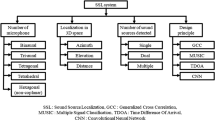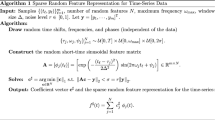Abstract
Underdetermined reverberant audio-source separation is an important issue in speech and audio processing. To solve this problem, many separation algorithms have been proposed, in which model parameter estimation is performed in the time–frequency domain, leading to permutation ambiguity and poor separation performance. Additionally, in the existing expectation–maximization (EM) algorithms, one of the crucial problem is that updating the model parameters at each iterative step is time-consuming. In this paper, we present an improved EM algorithm that combines nonnegative matrix factorization (NMF) and time differences of arrival (TDOA) estimation, avoiding the time consumption by properly selecting initial values of the EM algorithm. In the proposed algorithm, NMF source model is used to avoid the permutation ambiguity problem, and acoustic localization can be achieved by transforming the TDOA. Then, model parameters are updated to obtain better separation results. Finally, the source signals are separated using Wiener filters. The experimental results show that compared with existing blind separation methods, the proposed algorithm achieves better performance on source separation.







Similar content being viewed by others
References
X. Alameda-Pineda, S. Gannot, D. Kounades-Bastian, L. Girin, R. Horaud, A variational EM algorithm for the separation of time-varying convolutive audio mixtures. IEEE/ACM Trans. Audio Speech Lang. Process. 24(8), 1408–1423 (2016)
A. Al-Tmeme, W.L. Woo, S.S. Dlay, B. Gao, Underdetermined convolutive source separation using GEM-MU with variational approximated optimum model order NMF2D. IEEE ACM Trans. Audio Speech Lang. Process. 25(1), 35–49 (2017)
C. Blandin, A. Ozerov, E. Vincent, Multi-source TDOA estimation in reverberant audio using angular spectra and clustering. Signal Process. 91(10), 1950–1960 (2012)
R. Chai, G. Naik, T.N. Nguyen, S. Ling, Y. Tran, A. Craig, H. Nguyen, Driver fatigue classification with independent component by entropy rate bound minimization analysis in an EEG-based system. IEEE J Biomed Health Inform 21(3), 715–724 (2017)
Y. Chi, Guaranteed blind sparse spikes deconvolution via lifting and convex optimization. IEEE J. Select. Topics Signal Process. 10(4), 782–794 (2015)
J. Cho, D.Y. Chang, Underdetermined convolutive BSS: Bayes risk minimization based on a mixture of super-Gaussian posterior approximation. IEEE/ACM Trans. Audio Speech Lang. Process. 23(5), 828–839 (2015)
P. Comon, C. Jutten, Handbook of Blind Source Separation: Independent Component Analysis and Separation (Academic, Cambridge, 2010)
C.P. Demo, J. Srel, Cocktail Party Problem (Springer, New York, 2015)
S.C. Douglas, M. Gupta, H. Sawada, S. Makino, Spatiotemporal fastICA algorithms for the blind separation of convolutive mixtures. IEEE Trans. Audio Speech Lang. Process. 15(5), 1511–1520 (2007)
N.Q.K. Duong, E. Vincent, Under-determined reverberant audio source separation using a full-rank spatial covariance model. IEEE Trans. Audio Speech Lang. Process. 18(7), 1830–1840 (2010)
C. Fvotte, N. Bertin, J.L. Durrieu, Nonnegative matrix factorization with the Itakura–Saito divergence: with application to music analysis. Neural Comput. 21(3), 793 (2009)
Y. Guo, G. R. Naik, H. Nguyen, Single channel blind source separation based local mean decomposition for biomedical applications, in Engineering in Medicine and Biology Society 2013, pp. 6812–6815
Y. Guo, S. Huang, Y. Li, G.R. Naik, Edge effect elimination in single-mixture blind source separation. Circuits Syst. Signal Process. 32(5), 2317–2334 (2013)
Y. Hu, P.C. Loizou, Evaluation of objective quality measures for speech enhancement. IEEE Trans. Audio Speech Lang. Process. 16(1), 229–238 (2008)
D. Kitamura, N. Ono, H. Sawada, H. Kameoka, H. Saruwatari, Determined blind source separation unifying independent vector analysis and nonnegative matrix factorization. IEEE/ACM Trans. Audio Speech Lang. Process. 24(9), 1626–1641 (2016)
H. Liu, S. Liu, T. Huang, Z. Zhang, Y. Hu, T. Zhang, Infrared spectrum blind deconvolution algorithm via learned dictionaries and sparse representation. Appl. Optics 55(10), 2813 (2016)
G.R. Naik, S.E. Selvan, H.T. Nguyen, Single-channel EMG classification with ensemble-empirical-mode-decomposition-based ICA for diagnosing neuromuscular disorders. IEEE Trans. Neural Syst. Rehabil. Eng. 24(7), 734–743 (2016)
G. Naik, A. Altimemy, H. Nguyen, Transradial amputee gesture classification using an optimal number of sEMG sensors: an approach using ICA clustering. IEEE Trans. Neural Syst. Rehabil. Eng. 24(8), 837–846 (2016)
F. Nesta and M. Omologo, Convolutive underdetermined source separation through weighted interleaved ICA and spatio-temporal source correlation. In: International Conference on Latent Variable Analysis and Signal Separation, Lva/ica 2012, Tel Aviv, Israel, March 12–15, 2012. Proceedings, 2012, pp. 222–230
A. Ozerov, C. Fvotte, R. Blouet, J. L. Durrieu, Multichannel nonnegative tensor factorization with structured constraints for user-guided audio source separation. In: IEEE International Conference on Acoustics, Speech and Signal Processing, 2011, pp. 257–260
A. Ozerov, C. Fevotte, Multichannel nonnegative matrix factorization in convolutive mixtures for audio source separation. IEEE Trans. Audio Speech Lang. Process. 18(3), 550–563 (2010)
G. Pendharkar, G.R. Naik, H.T. Nguyen, Using blind source separation on accelerometry data to analyze and distinguish the toe walking gait from normal gait in ITW children. Biomed. Signal Process. Control 13(5), 41–49 (2014)
K. Rahbar, J.P. Reilly, A frequency domain method for blind source separation of convolutive audio mixtures. IEEE Trans. Speech Audio Process. 13(5), 832–844 (2005)
H. Sawada, S. Araki, S. Makino, Underdetermined convolutive blind source separation via frequency bin-wise clustering and permutation alignment. IEEE Trans. Audio Speech Lang. Process. 19(3), 516–527 (2010)
H. Sawada, H. Kameoka, S. Araki, N. Ueda, Multichannel extensions of non-negative matrix factorization with complex-valued data. IEEE Trans. Audio Speech Lang. Process. 21(5), 971–982 (2013)
C.H. Taal, R.C. Hendriks, R. Heusdens, J. Jensen, An algorithm for intelligibility prediction of timefrequency weighted noisy speech. IEEE Trans. Audio Speech Lang. Process. 19(7), 2125–2136 (2011)
E. Vincent, R. Gribonval, C. Fevotte, Performance measurement in blind audio source separation. IEEE Trans. Audio Speech Lang. Process. 14(4), 1462–1469 (2006)
L. Wang, Y. Chi, Blind deconvolution from multiple sparse inputs. IEEE Signal Process. Lett. 23(10), 1384–1388 (2016)
S. Xie, L. Yang, J.M. Yang, G. Zhou, Y. Xiang, Time-frequency approach to underdetermined blind source separation. IEEE Trans. Neural Netw. Learn. Syst. 23(2), 306–316 (2012)
Y. Xie, K. Xie, J. Yang, S. Xie, Underdetermined blind source separation combining tensor decomposition and nonnegative matrix factorization. Symmetry 10(10), 521 (2018)
J.-J. Yang, H.-L. Liu, Blind identification of the underdetermined mixing matrix based on k-weighted hyperline clustering. Neurocomputing 149(PB), 483–489 (2015)
Acknowledgements
The authors would like to thank the anonymous reviewers for their insightful comments and helpful critiques of the manuscript that helped improve this paper. This work was partially supported by the National Natural Science Foundation of China (Grants 613300032, 61773128, 61673126, U1701261). Additionally, this work was partially supported by the Postdoctoral Science Foundation of China, No. 2018M643022.
Author information
Authors and Affiliations
Corresponding author
Additional information
Publisher's Note
Springer Nature remains neutral with regard to jurisdictional claims in published maps and institutional affiliations.
Rights and permissions
About this article
Cite this article
Xie, Y., Xie, K., Yang, J. et al. Underdetermined Reverberant Audio-Source Separation Through Improved Expectation–Maximization Algorithm. Circuits Syst Signal Process 38, 2877–2889 (2019). https://doi.org/10.1007/s00034-018-1011-5
Received:
Revised:
Accepted:
Published:
Issue Date:
DOI: https://doi.org/10.1007/s00034-018-1011-5




